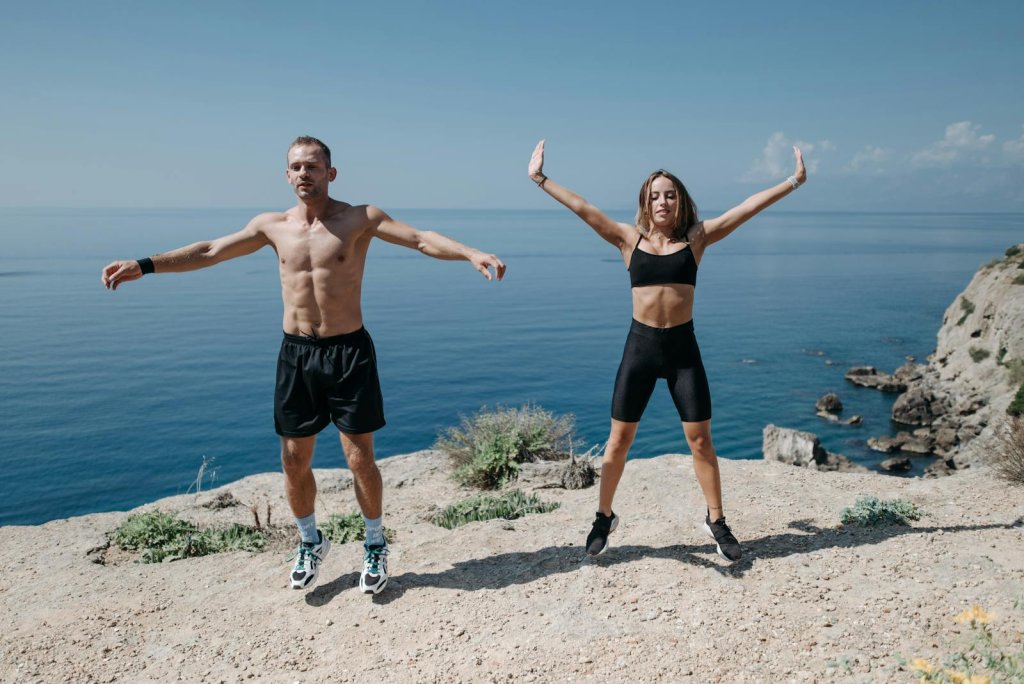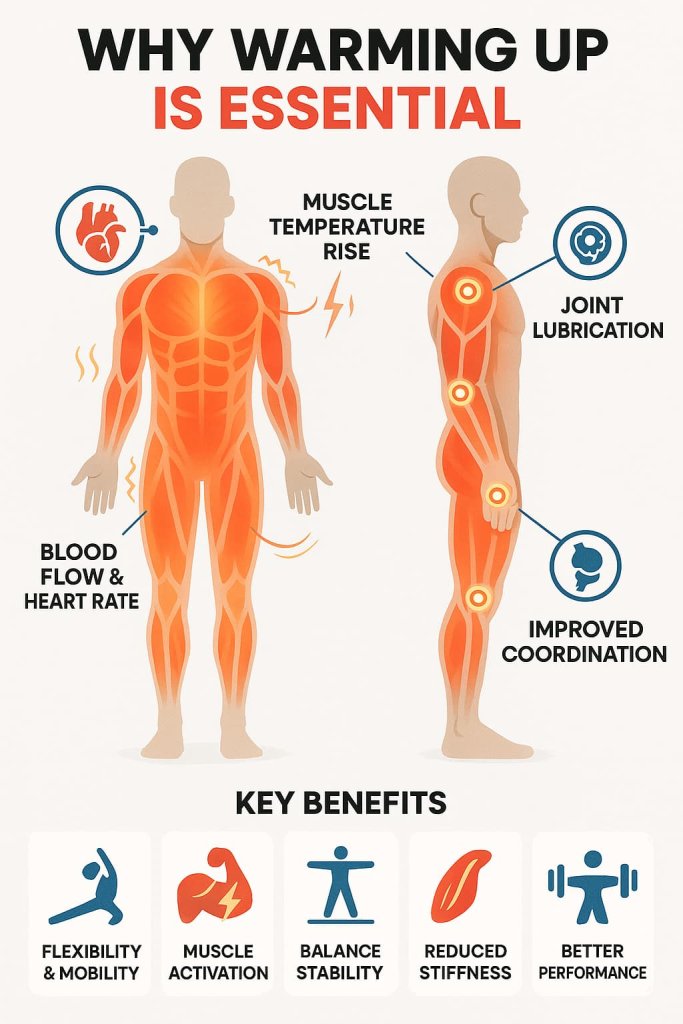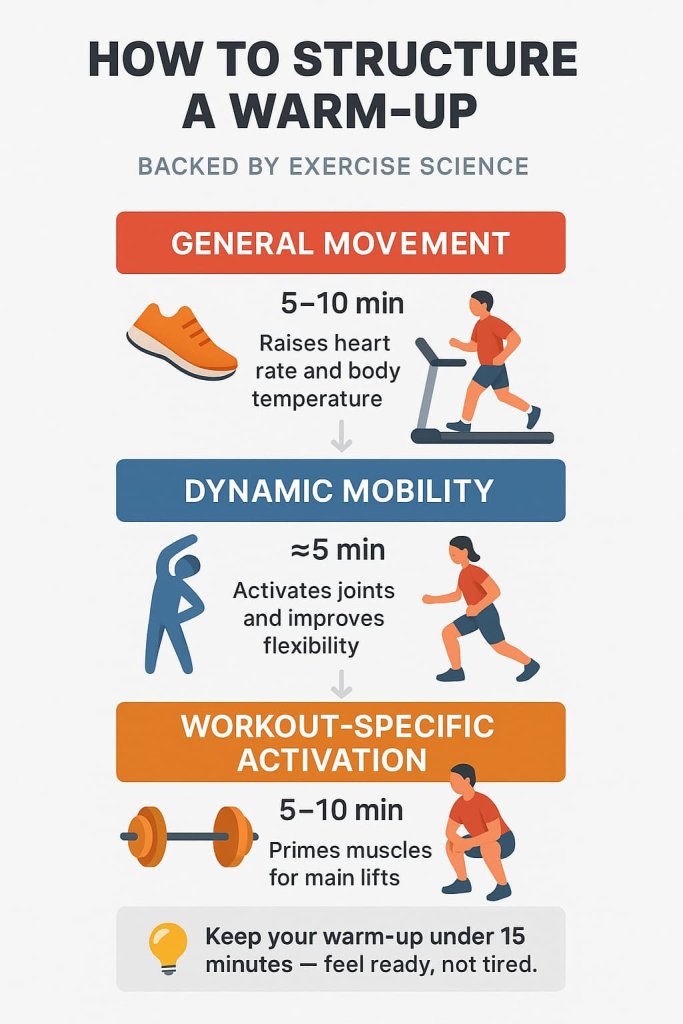Warming up before a workout boosts performance, prevents stiffness, and prepares your body and mind for maximum results. According to a systematic review and meta-analysis published in the Journal of Strength and Conditioning Research by Fradkin et al. (2010), warm-ups improved performance in approximately 79% of the studies reviewed, enhancing metrics such as power output, strength, and flexibility across various exercise types.

Whether you’re hitting the weights, running, or doing HIIT — skipping your warm-up is like starting a car in winter without letting the engine warm up first. In this guide, we’ll show you 17 of the best warm-up exercises backed by science to get you primed, mobile, and ready to crush your workout.
Why Warming Up Is Essential
Warming up increases muscle temperature, blood flow, and joint lubrication, which improve range of motion and coordination.
A recent meta-analysis found that using dynamic stretching as part of the warm-up led to statistically significant improvements in explosive performance (e.g. jump, sprint), whereas static stretching alone tended to diminish it.

Additionally, the American Heart Association (2025) notes that gradual pre-exercise movement helps the cardiovascular system adjust, reducing the risk of lightheadedness and muscle strain.
Key Benefits:
- Better flexibility and mobility
- Increased muscle activation
- Improved balance and stability
- Reduced stiffness or soreness
- Enhanced workout performance
How to Structure a Warm-Up (Science-Based)
A complete warm-up follows three stages:

- General Movement (5–10 minutes) – Low-intensity cardio like jogging or cycling to raise heart rate.
- Dynamic Mobility (5 minutes) – Controlled stretches and joint movements.
- Workout-Specific Activation (5–10 minutes) – Lighter versions of the main workout moves (e.g., bodyweight squats before barbell squats).
💡 Pro Tip: Keep your warm-up under 15 minutes total. You want to feel warm and ready, not fatigued.
17 Best Warm-Up Exercises Before Workout
Below are the 17 most effective warm-up exercises to elevate performance, enhance flexibility, and prevent injury — each explained in depth.
1. Jumping Jacks
Why it works:
Jumping Jacks are a time-tested total-body movement that rapidly increases circulation, core temperature, and oxygen delivery to muscles. This dynamic activity engages both the upper and lower body, promoting better coordination between limbs. It also prepares the nervous system for more complex movements, making it a perfect starter for any workout.
Muscles worked:
Quadriceps, hamstrings, calves, glutes, shoulders, chest, and core stabilizers.
How to do it:
- Stand tall with feet together and arms relaxed at your sides.
- Jump your feet out laterally as you raise your arms overhead.
- Jump back to the starting position.
- Continue at a steady, rhythmic pace for 30–60 seconds.
Trainer Tip:
Breathe steadily — inhale as you spread out, exhale as you return. Land softly on the balls of your feet to minimize joint stress. Keep knees slightly bent to absorb impact.
2. Arm Circles
Why it works:
Arm Circles enhance shoulder joint lubrication and improve upper-body mobility. This helps prevent impingement and shoulder tightness, which are common issues in pressing or overhead workouts. The movement stimulates synovial fluid production, which cushions and nourishes the shoulder joints.
Muscles worked:
Deltoids (anterior, lateral, posterior), rotator cuff muscles, trapezius.
How to do it:
- Stand upright with feet hip-width apart and arms extended horizontally.
- Make small forward circles for 20–30 seconds.
- Gradually increase the circle diameter, then reverse direction.
Trainer Tip:
Control the motion—don’t swing aggressively. Keep your torso still and avoid shrugging shoulders. This ensures you’re targeting the correct stabilizers.
3. High Knees
Why it works:
High Knees elevate heart rate quickly and dynamically stretch the hip flexors and lower body. They prepare your muscles for explosive movements like running, squatting, or jumping. They also activate your core and improve balance and coordination.
Muscles worked:
Quadriceps, hamstrings, hip flexors, calves, glutes, and abdominals.
How to do it:
- Stand with feet hip-width apart.
- Lift one knee to hip level while pumping the opposite arm forward.
- Alternate knees rapidly like running in place.
- Continue for 30–45 seconds.
Trainer Tip:
Maintain an upright posture and focus on driving your knees up rather than leaning forward. Engage your core to avoid arching your back.
4. Butt Kicks
Why it works:
This simple yet effective movement improves knee flexion mobility, enhances hamstring elasticity, and activates the posterior chain — all crucial for sprinting or leg day. It also helps balance muscle activation between the front and back of the legs.
Muscles worked:
Hamstrings, glutes, calves.
How to do it:
- Stand tall with arms relaxed.
- Jog in place, kicking heels up toward your glutes with each step.
- Keep rhythm consistent for 30–45 seconds.
Trainer Tip:
Avoid excessive back movement; keep the motion controlled and smooth. To challenge coordination, synchronize arm swings as if you were sprinting.
5. Walking Lunges
Why it works:
Walking lunges improve hip mobility, knee stability, and muscular activation through a full range of motion. They mimic athletic movements like sprint starts or jumps and activate nearly every lower-body muscle group.
Muscles worked:
Glutes, quadriceps, hamstrings, hip flexors, calves, and core.
How to do it:
- Stand tall, step forward with one leg into a lunge.
- Lower until both knees are bent at 90°.
- Push through your front heel to stand, then step into the next lunge.
- Repeat for 10–12 reps per leg.
Trainer Tip:
Keep your torso upright and core tight. Avoid letting the front knee drift past your toes. For extra activation, pause briefly at the bottom.
6. Leg Swings
Why it works:
Leg swings improve dynamic flexibility and hip mobility — vital for squats, lunges, and running. They help loosen up tight hip flexors and hamstrings caused by long sitting hours.
Muscles worked:
Hip flexors, hamstrings, glutes, quadriceps, adductors, abductors.
How to do it:
- Stand beside a wall for support.
- Swing one leg forward and backward in a controlled arc for 15–20 reps.
- Then swing it side to side across the body for another 15–20.
Trainer Tip:
Control the swing — avoid jerky motion. Gradually increase the height only as flexibility allows.
7. Hip Circles
Why it works:
Hip Circles target one of the most commonly tight areas in athletes — the hips. This move lubricates the hip joint, increases synovial fluid, and enhances range of motion, making squats, deadlifts, and running smoother.
Muscles worked:
Hip flexors, glutes, obliques, lower back, and abductors.
How to do it:
- Stand tall with hands on your hips.
- Slowly rotate your hips in a wide circle clockwise for 10 reps.
- Repeat in the opposite direction.
Trainer Tip:
Engage your core and move slowly to feel the joint rotation. Keep knees slightly bent to reduce strain on the lower back.
8. Shoulder Rolls
Why it works:
Shoulder rolls reduce tension in the upper traps and neck while enhancing blood flow around the scapular muscles. This helps prevent stiffness before pressing, rowing, or overhead exercises.
Muscles worked:
Deltoids, trapezius, levator scapulae, rhomboids.
How to do it:
- Stand or sit upright.
- Roll both shoulders forward in a circular motion for 10 reps.
- Reverse the direction for another 10.
Trainer Tip:
Keep the motion slow and controlled. Imagine drawing a smooth circle with your shoulders — don’t rush.
9. Bodyweight Squats
Why it works:
Bodyweight squats are a functional compound warm-up exercise that fires up major lower-body muscles while improving joint alignment and stability. It mirrors the mechanics of loaded squats without strain.
Muscles worked:
Quadriceps, glutes, hamstrings, calves, and core stabilizers.
How to do it:
- Stand with feet shoulder-width apart, toes slightly turned out.
- Lower hips back and down as if sitting into a chair.
- Keep your chest upright and knees in line with toes.
- Push through heels to return to standing. Do 12–15 reps.
Trainer Tip:
Focus on form, not speed. Push knees out slightly and brace your core throughout.
10. Arm Swings
Why it works:
This move enhances shoulder and chest mobility while increasing upper-body blood flow. Perfect before push-ups, presses, or any upper-body workout.
Muscles worked:
Pectorals, deltoids, biceps, and upper back.
How to do it:
- Stand tall with feet shoulder-width apart.
- Swing both arms forward and across your chest, then outward again.
- Repeat rhythmically for 20–30 reps.
Trainer Tip:
Keep movements controlled — don’t force the arms too far back. Slightly bend elbows to protect the joints.
11. Torso Twists
Why it works:
Torso Twists increase rotational mobility through the spine and torso. This helps improve posture and prepares you for sports or exercises that require twisting or turning motions.
Muscles worked:
Obliques, erector spinae, transverse abdominis, lower back.
How to do it:
- Stand tall with feet shoulder-width apart.
- Extend arms at chest level.
- Rotate your torso side to side in a controlled rhythm, keeping hips steady.
- Do 15–20 reps total.
Trainer Tip:
Keep movements smooth. Avoid swinging your arms — focus on rotating through your core.
12. Cat-Cow Stretch
Why it works:
Improves spinal flexibility and warms up your core and back stabilizers. Ideal for loosening stiffness before deadlifts or overhead work.
Muscles worked:
Spinal erectors, abdominals, shoulders, lats.
How to do it:
- Begin on all fours with hands under shoulders, knees under hips.
- Inhale as you arch your spine (Cow pose).
- Exhale as you round your back toward the ceiling (Cat pose).
- Repeat for 8–10 slow cycles.
Trainer Tip:
Move with your breath — the rhythm enhances mobility and circulation in the spine.
13. Plank to Downward Dog
Why it works:
Combines strength, flexibility, and mobility — engaging your shoulders, core, and hamstrings simultaneously. Excellent before push, pull, or leg sessions.
Muscles worked:
Shoulders, triceps, core, hamstrings, calves.
How to do it:
- Start in a high plank position.
- Push hips up and back into a Downward Dog pose.
- Hold for 2 seconds, then return to plank.
- Repeat 8–10 times.
Trainer Tip:
Drive through your palms and press heels toward the floor for deeper activation.
14. Glute Bridges
Why it works:
Glute bridges wake up dormant glutes and stabilize the pelvis. They counteract sitting-induced tightness and reduce the risk of lower-back strain.
Muscles worked:
Glutes, hamstrings, core, lower back.
How to do it:
- Lie on your back with knees bent and feet flat.
- Press through your heels to lift hips until your body forms a straight line.
- Squeeze glutes at the top, hold for 2 seconds, and lower slowly.
- Perform 12–15 reps.
Trainer Tip:
Avoid over-arching your back. Focus on squeezing glutes, not pushing from your spine.
15. Inchworm Walkouts
Why it works:
An excellent full-body mobilizer that stretches the hamstrings while engaging shoulders and core. It also increases circulation and flexibility dynamically.
Muscles worked:
Shoulders, chest, hamstrings, calves, abs.
How to do it:
- Stand tall, hinge at hips to touch the floor.
- Walk hands forward into a plank.
- Pause briefly, then walk hands back toward your feet.
- Perform 8–10 reps.
Trainer Tip:
Keep your legs straight to feel a deep hamstring stretch. Move slowly to stay in control.
16. World’s Greatest Stretch
Why it works:
A total-body mobility drill improving flexibility in hips, hamstrings, and spine — often used by elite athletes.
Muscles worked:
Hip flexors, glutes, hamstrings, adductors, thoracic spine, shoulders.
How to do it:
- Step into a deep lunge with right foot forward.
- Place left hand on the ground and rotate torso toward the right knee, reaching the right arm overhead.
- Hold briefly, return, and switch sides.
Trainer Tip:
Perform slowly, inhaling as you twist and exhaling as you reach to deepen the stretch.
17. Skipping or Jump Rope
Why it works:
Finishes your warm-up by boosting coordination, rhythm, and cardiovascular readiness. It improves foot speed and leg elasticity — perfect before high-intensity training.
Muscles worked:
Calves, quads, hamstrings, shoulders, forearms, abs.
How to do it:
- Hold the jump rope handles at hip level.
- Swing the rope overhead and jump lightly on the balls of your feet.
- Continue for 60–90 seconds.
Trainer Tip:
Keep jumps small and quick. Stay relaxed through your wrists and forearms to prevent fatigue.
Warm-Up Tips for Maximum Results
- Gradually increase intensity every 2–3 minutes.
- Avoid static stretches before lifting; save them for post-workout.
- Focus on movement patterns that mimic your upcoming exercises.
- Stay consistent — warm up before every session to reduce soreness and enhance longevity.
Example 10-Minute Full-Body Warm-Up Routine
| Time | Exercise | Focus |
|---|---|---|
| 0–2 min | Jumping Jacks | Cardio |
| 2–4 min | Arm Circles + Leg Swings | Mobility |
| 4–6 min | Walking Lunges | Lower-body activation |
| 6–8 min | Plank to Downward Dog | Core & shoulder warm-up |
| 8–10 min | Bodyweight Squats | Workout readiness |
Common Warm-Up Mistakes to Avoid
Avoid these quick warm-up errors for better performance:
- Skipping it: Cold muscles = higher injury risk.
- Static stretching first: Lowers strength — use dynamic moves.
- Rushing through: Warm up gradually, not hastily.
- Same routine always: Match your warm-up to the workout.
- Overdoing it: Keep it under 15 minutes.
- No mobility work: Add hip, shoulder, or spine drills.
- Lack of focus: Use warm-up time to get mentally ready.
✅ Trainer Tip: A good warm-up should wake you up — not wear you out.
FAQ — Warm-Up Exercises
1. How long should a warm-up last?
10–15 minutes is ideal for most workouts.
2. Should I stretch before or after my workout?
Do dynamic stretches before and static stretches after.
3. Can I skip warm-ups if I’m short on time?
No — even 5 minutes of dynamic movement can prevent poor performance or injury.
4. Are warm-ups different for strength vs. cardio?
Slightly. Strength warm-ups should mimic your lifts, while cardio can be more general.
5. What’s the biggest mistake people make?
Holding static stretches before lifting — it reduces muscle power temporarily.
Conclusion
A proper warm-up isn’t optional — it’s your performance amplifier. By dedicating just 10–15 minutes to these 17 warm-up exercises, you’ll lift heavier, move smoother, and recover faster.
💪 Next step: Add this warm-up routine before every workout and feel the difference in your energy, flexibility, and performance.
